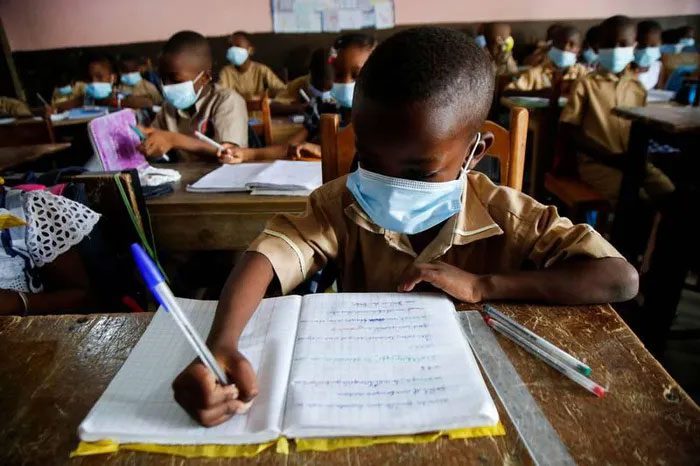Research findings indicate that in regions with warm climates, the peak of the Covid-19 pandemic typically occurs during the summer.
American researchers have shown that the spread of Covid-19 decreases to its lowest levels when temperatures range from 17°C to 24°C. This discovery provides a more nuanced perspective compared to previous studies, which suggested that the virus spreads more vigorously at lower temperatures.

Students wearing masks attending school in Abidjan, Ivory Coast. (Photo: Reuters)
“Back in 2020, there were many assessments suggesting that SARS-CoV-2, the virus causing Covid-19, would disappear with the arrival of summer. We were uncertain whether that would be the case. Often, we observed that the virus strain’s infectivity decreased as temperatures dropped,” stated Antarpreet Jutla, a professor at the University of Florida and a senior author of the latest research.
The study indicates that when surrounding temperatures fluctuate between 17°C and 24°C, people are more inclined to participate in outdoor activities. Below and above this temperature range, individuals tend to stay indoors, thereby doubling the risk of infection.
When indoors, people tend to congregate closely, which facilitates the spread of the virus, often breathing in an environment that is “mechanically controlled” by devices such as air conditioners. In such systems, the air is typically drier, making it easier for respiratory droplets containing the virus to circulate.
“When the surrounding temperature is between 17°C and 24°C, the number of Covid-19 cases decreases in both cold and warm climates. This temperature range encourages outdoor activities, allowing people to be exposed to circulating air. Recently, there have been many cases of large gatherings in warm climates leading to outbreaks, including religious activities in India, Pakistan, Malaysia, and South Korea,” the preliminary research results published in the American Journal of Tropical Medicine and Hygiene stated.
Initially, researchers focused on clarifying how temperature affects the virus’s spread in both warm and cold regions of the United States, using data from 2020 to develop a complex mathematical model to predict when the risk of infection is highest.
Instead of publishing results based solely on 2020 data, the research team waited to confirm the accuracy of the findings throughout 2021. “We decided to wait and see if those findings held true for the 2021 data. The results were indeed consistent, and the correlation between [surrounding temperature and infection rates] was even stronger than in 2020,” Professor Jutla remarked.
Currently, the model has been validated in the United States, with data supplemented from India. Scientists are also reassessing this model with the Omicron variant and plan to validate it on a global scale.
According to Jutla, seasonal influenza, another respiratory illness, typically spreads vigorously during winter. This is when temperatures drop to colder levels, leading people to spend more time indoors. However, with the SARS-CoV-2 virus, the situation appears more complex. Many regions around the world may experience two peaks of infection within a year due to temperature factors.
Specifically, in regions where the surrounding temperature does not exceed 24°C, researchers predict there will only be one peak of infection in winter. In areas with warmer climates, where temperatures do not drop below 17°C in winter, the peak typically occurs in summer. Regions with moderate temperatures may experience two peaks of outbreaks throughout the year.

















































